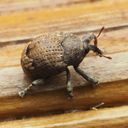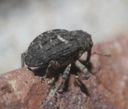Cryptorhynchini
Cryptorhynchini
Classification
- Phylum: Arthropoda
- Subphylum: Hexapoda
- Class: Insecta
- Order: Coleoptera
- Suborder: Polyphaga
- Superfamily: Curculionoidea
- Family: Curculionidae
- Subfamily: Cryptorhynchinae
- Tribe: Cryptorhynchini
Pronunciation
How to pronounce Cryptorhynchini: /ˌkrɪptoʊˈrɪŋkɪnaɪ/
These audio files are automatically generated. While they are not always 100% accurate, they are a good starting point.
Images






Summary
Onidistus is a genus of hidden snout weevils within the family Curculionidae, comprising about four recognized species mainly found in Australia and the South Pacific.
Physical Characteristics
Hidden snout weevils have an elongated shape with a pronounced snout and are typically small to medium in size.
Identification Tips
Look for the distinctive elongated snout and the specific coloration and patterns on the elytra of the beetles.
Habitat
Onidistus species are typically found in forested areas, associating with specific plant species in their local habitats.
Distribution
The genus Onidistus is distributed across Australia and the South Pacific.
Diet
The diet typically consists of plant material, particularly leaves, which they feed on as larvae and adults.
Life Cycle
Life cycles involve egg laying on or near host plants, with larval stages developing within the soil or plant tissue.
Reproduction
Little specific information is available, but reproduction likely involves the deposition of eggs on host plants by females.
Predators
Natural predators include birds, other insects, and various predatory arthropods.
Ecosystem Role
As herbivores, they play a role in the dynamics of their ecosystems, influencing plant populations and serving as prey for various predators.
Collecting Methods
- Hand collecting from vegetation
- Light trapping
- Sweep netting
Preservation Methods
- Ethanol preservation
- Pinning
- Drying specimens
Evolution
The evolutionary history of the genus aligns with that of the Curculionidae family, known for its diversity and adaptation to various habitats.
Misconceptions
They are often mistaken for other small beetles but can be distinguished by their unique snout and body shape.
Tags
- beetles
- Curculionidae
- cryptorhynchini